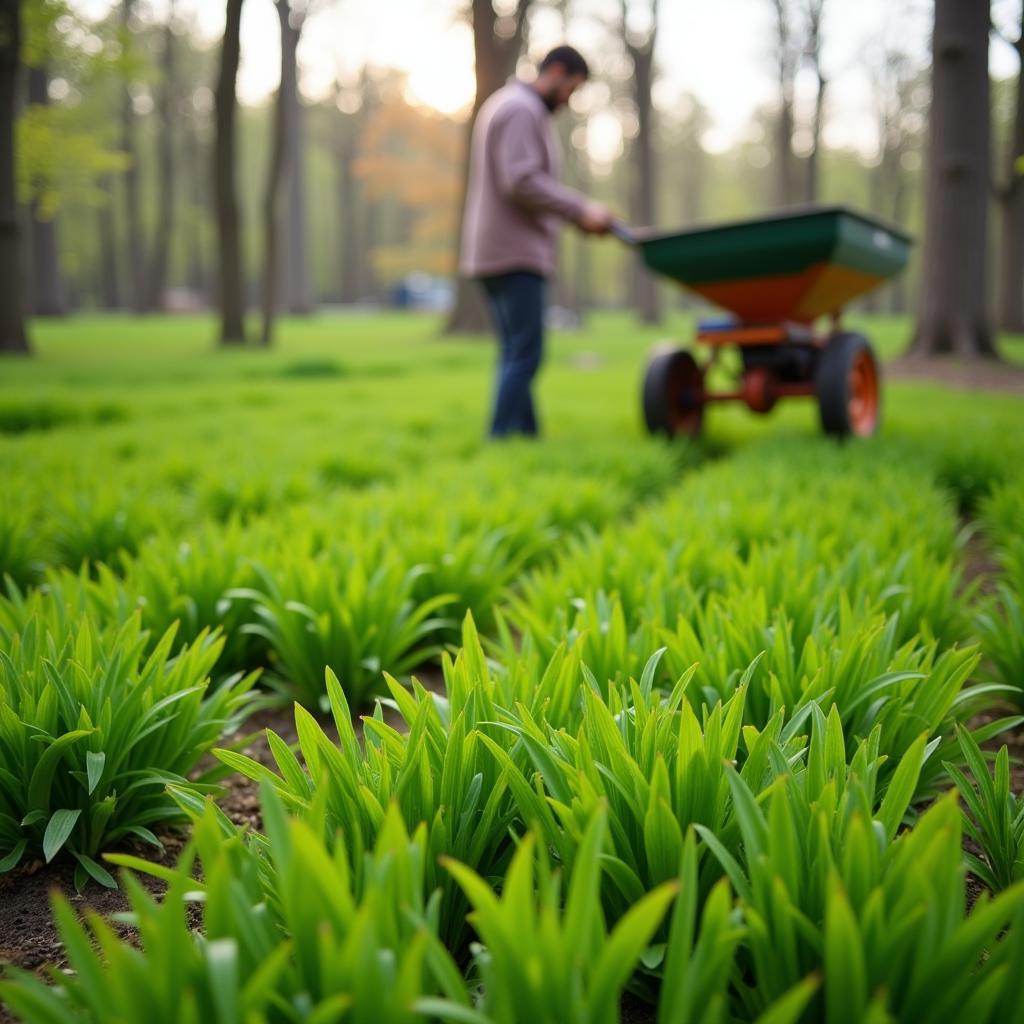Knowing When To Fertilize A Food Plot is crucial for its success. Just like any other plant, food plot species need the right nutrients at the right time to flourish. This guide will equip you with the knowledge to optimize your food plot fertilization, ensuring your plots thrive and attract abundant wildlife.
Understanding the Importance of Soil Testing
Before you even think about reaching for the fertilizer, getting a soil test is paramount. This simple step offers a wealth of information about your plot’s soil, including its pH level and the concentration of essential nutrients. Think of it as a blood test for your food plot – it gives you a clear picture of its health!
 Soil Test Kit
Soil Test Kit
Soil testing kits are readily available at most garden centers and online retailers. Once you get your results, you can use them to determine the precise type and amount of fertilizer your plot needs. This tailored approach not only saves you money in the long run but also prevents over-fertilization, which can be detrimental to the environment.
Timing is Everything: When to Fertilize
The optimal time to fertilize your food plot largely depends on your geographical location and the specific plant species you’re growing. However, there are some general guidelines you can follow:
Spring Fertilization: Fueling Early Growth
In most regions, spring is a prime time for fertilizing food plots. This is when the soil is warming up, and plants are starting their active growth cycle. A dose of fertilizer in early spring provides the necessary nutrients for strong root development and lush foliage.
Key Considerations for Spring Fertilization:
- Soil Temperature: Wait until the soil has thawed and reached a consistent temperature of around 50°F (10°C) before applying fertilizer.
- Rainfall: Spring showers can help distribute nutrients, but be mindful of heavy rainfall that can lead to runoff and nutrient loss.
- Plant Needs: Research the specific nutrient requirements of the species in your food plot and choose a fertilizer that aligns with those needs.
 Spring Food Plot Fertilization
Spring Food Plot Fertilization
Fall Fertilization: Promoting Winter Hardiness
Fall fertilization is crucial for cool-season food plots, such as those containing oats for food plots or food plot rye. These species benefit from a nutrient boost in the fall to encourage root development and enhance their ability to withstand harsh winter conditions.
Key Considerations for Fall Fertilization:
- Timing is Key: Aim to fertilize around 6-8 weeks before the first expected frost in your area. This allows the plants sufficient time to absorb the nutrients before going dormant.
- Choose the Right Fertilizer: Opt for a fertilizer with a higher phosphorus content in the fall, as phosphorus is essential for root development.
Fertilization Methods for Food Plots
The method you choose for applying fertilizer to your food plot will depend on the size of your plot and your personal preferences.
Broadcasting: Covering Large Areas
Broadcasting is a common method for fertilizing large food plots. It involves evenly spreading fertilizer granules over the entire area using a handheld spreader or a tractor-mounted spreader.
Banding: Targeted Nutrient Delivery
Banding involves applying fertilizer in concentrated bands near the plant rows. This method is more precise than broadcasting and can be more efficient, especially for smaller food plots.
 Fertilizer Banding Food Plot
Fertilizer Banding Food Plot
Common Mistakes to Avoid
Even with the best intentions, it’s easy to make mistakes when it comes to food plot fertilization. Here are a few common pitfalls to avoid:
- Over-Fertilization: More is not always better. Applying too much fertilizer can damage plants, contaminate water sources, and lead to an imbalance in soil nutrients. Always follow the recommended application rates on the fertilizer label.
- Incorrect Timing: Fertilizing at the wrong time can be ineffective or even harmful. For example, fertilizing during a drought can lead to fertilizer burn, while fertilizing too late in the fall may not benefit cool-season plots.
- Ignoring Soil pH: Soil pH plays a crucial role in nutrient availability. If your soil pH is too high or too low, certain nutrients become locked out, rendering them inaccessible to plants.
Frequently Asked Questions about Food Plot Fertilization
Q: Can I use the same fertilizer for all my food plots?
A: It’s best to have your soil tested for each food plot, as soil conditions can vary even within a small area.
Q: Is organic fertilizer better for food plots?
A: Both organic and synthetic fertilizers can be effective. Organic fertilizers release nutrients more slowly, while synthetic fertilizers offer faster results. The best choice depends on your specific needs and preferences.
Q: How often should I fertilize my food plots?
A: A soil test can help you determine the appropriate fertilization frequency. In general, most food plots benefit from annual fertilization, either in the spring or fall.
Need More Help with Your Food Plots?
For personalized advice on food plot fertilization or to explore other aspects of food plot management, check out our related articles:
- Oats for food plots
- Lablab food plot
- Food plot rye
- Best liquid fertilizer for food plots
- Best fall food plot seed
Contact us at Phone Number: 02437655121, Email: minacones@gmail.com. Or visit our address: 3PGH+8R9, ĐT70A, thôn Trung, Bắc Từ Liêm, Hà Nội, Việt Nam. We have a dedicated customer support team available 24/7.